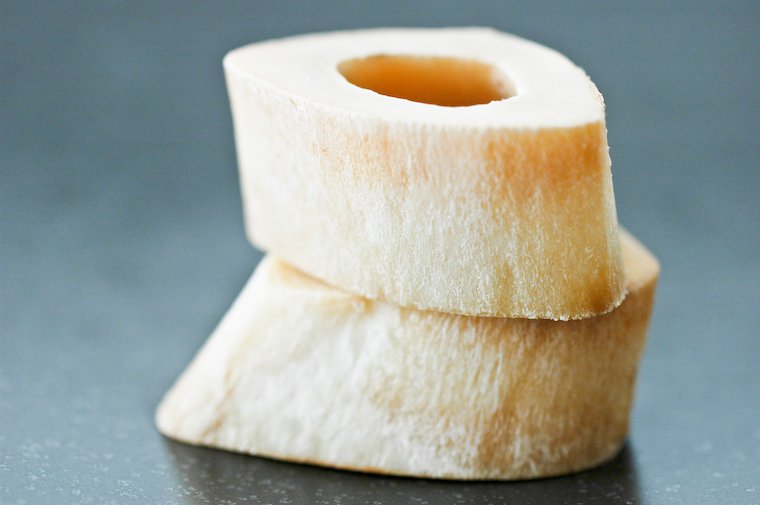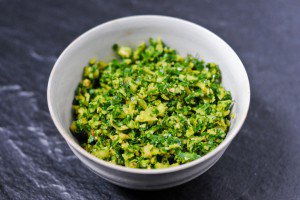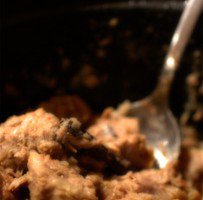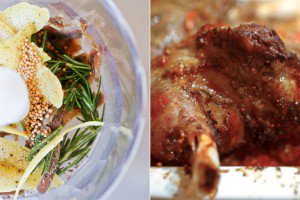Complaining about the weather is a national sport in France, but as is true of most sports — except perhaps for swimming — I am not very good at it. I have generally adopted the maxim, “Don’t worry about the things you can’t control,” and while I will do the chit-chat thing with taxi drivers and random people seeking shelter under the same awning as me (before I suddenly remember that all my windows are open and have to run back home under sheets of rain), I don’t really mind that August has been so lousy in the weather department. I figure this puts us first on the list for a really beautiful Indian summer, and it also opens the door to nice summer stews, which one can prepare in one’s recently acquired yet very old cast-iron pot.
Osso buco has entered the traditional French repertoire a long, long time ago, and this is my take on the French take on this dish.
Osso buco is an Italian stew of braised veal shank, onions, and tomatoes, spiked with garlic and lemon zest, and it is the dish I decided to make to show the unseasonal temperatures I held them no grudges. The name means, literally, “pierced bone”, as the sauce gets its rich flavor from the veal bones and the tender marrow that’s hiding inside.
I had had this dish before but had never made it myself, so I turned to a few of my cooking references to see what they had to say — the handbook we used at my cooking class, L’Art Culinaire Moderne, and Escoffier’s Guide culinaire (published in English as The Complete Guide to the Art of Modern Cookery). I took in their advice with a respectfully bowed head, and did things my way.
As you will no doubt have noticed, the above-mentioned references are French, not Italian (The Silver Spoon cookbook is on my wish list), but osso buco has entered the traditional French repertoire a long, long time ago, and this is my take on the French take on this dish. I am aware that your Italian grandmother’s recipe may be marginally or even dramatically different; I hope she will forgive me and invite me into her kitchen to show me how it’s really done. Talk to her about it.

Have you tried this? Share your pics on Instagram!
Please tag your pictures with #cnzrecipes. I'll share my favorites!
Ingredients
- 2 tablespoons olive oil
- 1/4 cup flour
- 6 slices veal shank, about 1.5 kg -- have the butcher tie each of the slices with string, so they won't fall apart as they cook
- Salt, pepper
- 2 garlic cloves, peeled and minced
- 1 kg (2 pounds) yellow onions, peeled and quartered
- 1 kg (2 pounds) ripe tomatoes
- 2 bay leaves
- 2 sprigs fresh thyme (or 1 teaspoon dried thyme)
- 1 cup dry white wine
- 1 cup good-quality stock (or just water)
- The zest from half a lemon, finely grated
- Gremolata, for serving
Instructions
- Heat one tablespoon olive oil in a large pot or Dutch oven over medium-high heat. Pour the flour in a soup plate. Dredge the meat with flour, working with one slice at a time and shaking it well afterwards to remove excess flour. Place half of the meat in the pot, season with salt and pepper, and cook for a few minutes on each side until nicely golden. Set the meat aside on a clean plate, and repeat with one more tablespoon olive oil and the remaining meat. Once all the meat is browned, set all the meat aside on the plate.
- Lower the heat to medium. Add the garlic, onions, and 2 tablespoons water into the pot, and cook for 10 minutes or until softened, stirring regularly to avoid coloring.
- Carve out the stems from the tomatoes, quarter them, and discard the seeds and juices. When the onions are softened, add the tomatoes, bay leaves, and thyme, and stir to combine. Season with salt and pepper. Arrange the meat over the vegetables, pour the wine and stock over the meat, and bring to a simmer. Cover and cook for an hour and a half, stirring from time to time, until the meat is very tender. An hour into the cooking, add the lemon zest.
- Remove the lid, turn the heat up to high, and cook until the sauce is reduced by half and thick enough to cling to the meat, stirring frequently to prevent the sauce from burning at the bottom of the pot. Taste the sauce, adjust the seasoning, and serve with plenty of gremolata for sprinkling, and a side of rice, risotto, or fresh pasta.
Notes
- No need to remove the string from the slices before serving.
- The marrow inside the bone is edible, and particularly delicious when spread on a piece of crusty bread and sprinkled with fleur de sel.














